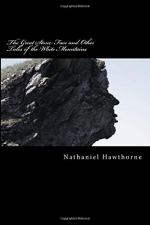The Cynic, having cast aside his spectacles, wandered about the world, a miserable object, and was punished with an agonizing desire of light, for the wilful blindness of his former life. The whole night long, he would lift his splendor-blasted orbs to the moon and stars; he turned his face eastward, at sunrise, as duly as a Persian idolater; he made a pilgrimage to Rome, to witness the magnificent illumination of St. Peter’s Church; and finally perished in the great fire of London, into the midst of which he had thrust himself, with the desperate idea of catching one feeble ray from the blaze that was kindling earth and heaven.
Matthew and his bride spent many peaceful years, and were fond of telling the legend of the Great Carbuncle. The tale, however, towards the close of their lengthened lives, did not meet with the full credence that had been accorded to it by those who remembered the ancient lustre of the gem. For it is affirmed that, from the hour when two mortals had shown themselves so simply wise as to reject a jewel which would have dimmed all earthly things, its splendor waned. When other pilgrims reached the cliff, they found only an opaque stone, with particles of mica glittering on its surface. There is also a tradition that, as the youthful pair departed, the gem was loosened from the forehead of the cliff, and fell into the enchanted lake, and that, at noontide, the Seeker’s form may still be seen to bend over its quenchless gleam.
Some few believe that this inestimable stone is blazing as of old, and say that they have caught its radiance, like a flash of summer lightning, far down the valley of the Saco. And be it owned that, many a mile from the Crystal Hills, I saw a wondrous light around their summits, and was lured, by the faith of poesy, to be the latest pilgrim of the great carbuncle.
SKETCHES FROM MEMORY
THE NOTCH OF THE WHITE MOUNTAINS
It was now the middle of September. We had come since sunrise from Bartlett, passing up through the valley of the Saco, which extends between mountainous walls, sometimes with a steep ascent, but often as level as a church aisle. All that day and two preceding ones we had been loitering towards the heart of the White Mountains—those old crystal hills, whose mysterious brilliancy had gleamed upon our distant wanderings before we thought of visiting them. Height after height had risen and towered one above another till the clouds began to hang below the peaks. Down their slopes were the red pathways of the slides, those avalanches of earth, stones and trees, which descend into the hollows, leaving vestiges of their track hardly to be effaced by the vegetation of ages. We had mountains behind us and mountains on each side, and a group of mightier ones ahead. Still our road went up along the Saco, right towards the centre of that group, as if to climb above the clouds in its passage to the farther region.




